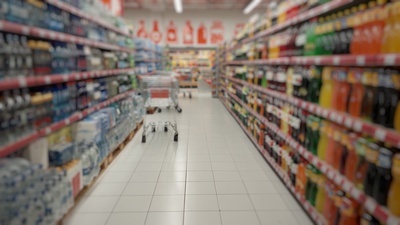New Research Debunks Fears of Supermarket Surge Pricing with Electronic Shelf Labels
UC San Diego study offers a critical piece of evidence—digital pricing technology is not leading to higher prices at checkout
Published Date
Story by:
Media contact:
Share This:
Article Content
Amid growing political concerns that supermarkets are quietly gouging shoppers through dynamic “surge pricing,” a new study from the University of California Rady School of Management offers a surprising conclusion: it’s not happening.
The working paper, co-authored by Rady economist Robert Sanders and University of Texas at Austin economist Ioannis Stamatopoulos, analyzes over 180 million product-level observations before and after the introduction of electronic shelf labels (ESLs)—the digital tags replacing traditional paper price stickers in many stores. The researchers find no evidence that ESLs have ushered in real-time pricing spikes, even during periods of high inflation.
“The price of groceries has been front and center of national politics for some time, so we wanted to empirically test a claim that many prominent lawmakers have made, that electronic labels lead to price gouging," said Sanders, an associate professor of marketing and analytics at the Rady School. “We find there is essentially no change in pricing behavior after these digital labels are installed.”

A Timely Analysis Amid Political Scrutiny
Among heightened public anxiety about food prices, prominent lawmakers, including Senators Elizabeth Warren and Bernie Sanders as well as NYC Democratic mayoral candidate Zohran Mamdani, have raised alarms about “surge pricing” in grocery stores, likening the technology to price hikes seen in ride-sharing apps like Uber or dynamic airline ticketing. There has also been legislation introduced to ban the labels in Arizona, Rhode Island and Main.
But according to the UC San Diego study, which is the first to investigate whether electronic labels lead to price gouging, these concerns are misplaced.
“Unlike Uber or hotels, grocery stores don't make money on a single item—they make money on your entire basket and your long-term loyalty,” said Stamatopoulos, an associate professor of information, risk, and operations management at UT Austin’s McCombs School of Business. “Using surge pricing could alienate shoppers and drive them away permanently, which is the last thing grocers want.”
Inside the Data: One in 20,000 Products Affected
To test the surge pricing theory, Sanders and Stamatopoulos examined price data across 114 stores in four U.S. states. These stores gradually adopted ESLs between October 2022 and mid-2024. The researchers looked specifically for short-lived, unexplained price hikes—the hallmark of surge pricing.
Before ESL installation, they found just one in every 20,000 products showed any sign of such behavior.
And after ESLs were added?
The number rose from 0.0050% to 0.0006% of products. That’s a change of just 0.0006 percentage points.
“If digital labels were causing surge pricing, you’d expect a visible spike in price changes—more frequent and more localized,” said Sanders. “Instead, we saw no meaningful difference before and after installation.”
What’s Actually Driving Price Changes?
The study also provides insight into what does drive price fluctuations in grocery stores.
According to the authors, base prices tend to follow wholesale costs and competitor pricing, whereas most short-term price changes are driven by manufacturer promotions—things like “buy one, get one free” deals or seasonal discounts. These discounts are usually planned well in advance and unrelated to real-time local conditions.
In fact, price uniformity remained strong throughout the study period. The researchers found that when prices did change, they did so consistently across the entire chain—not locally based on store-specific demand or weather.
The study also offers a compelling theory for why grocery retailers don’t spike their prices with the use of ESLs, even if the technology makes it easier to do so: it’s simply not good business.
“Grocery stores make thin margins on individual items and rely heavily on customer loyalty,” said Stamatopoulos. “Raising prices unexpectedly—even on a single item—risks alienating shoppers and sending them to competitors."
“Protecting consumers and making sure prices are competitive and transparent is absolutely important. But we find targeting digital shelf labels as a source of price gouging has no basis in reality and is a distraction from the real drivers of food costs.”

Policy Implications and a Look Ahead
The findings contradict claims from watchdogs and lawmakers like Sen. Warren as well as Sen. Sherrod Brown, who cited ESLs as a possible tool for “corporate profiteering” in letters to Kroger and Walmart.
“Protecting consumers and making sure prices are competitive and transparent is absolutely important,” said Sanders. “But we find targeting digital shelf labels as a source of price gouging has no basis in reality and is a distraction from the real drivers of food costs.”
In fact, the researchers note that ESLs could actually benefit low-income shoppers and reduce food waste sent to landfills, a key contributor to climate change. By making it easier to apply dynamic discounts to items nearing expiration—such as fresh produce or dairy—stores can help ensure these goods reach families in need instead of ending up in landfills. Previous research from Sanders finds that the use of ESLs may actually be more effective than organic food waste bans, which are enacted in 11 states.
Dynamic pricing is already happening in many parts of Europe, where ESL adoption is more advanced.
“The U.S. is behind Europe when it comes to this technology,” said Stamatopoulos. “But the European experience also shows it’s not being used for surge pricing. It’s being used to reduce waste and improve access to healthy food.”
The working paper is also co-authored by Robert Bray of Northwestern University’s Kellogg School of Management
Read the full paper, Electronic shelf labels have not led to surge pricing in US grocery retail, despite regulator concern.
Learn more about research and education at UC San Diego in: Climate Change
Share This:
Stay in the Know
Keep up with all the latest from UC San Diego. Subscribe to the newsletter today.




